Two-pipe heating system for a private house - a brief overview of the device and installation principles
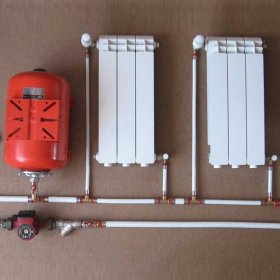
Water heating system is extremely common. According to statistics, more than two-thirds of all buildings are heated in this way. However, the concept of "water-based heating system" is quite general, it includes many varieties. Among them - a two-pipe heating system, a practical and popular way to heat your home.
Content
The principle of operation and advantages of this scheme
The basic principle of operation of heating structures operating with water is maintained. The system is a closed loop through which the heated coolant circulates from the heater to the radiators and back.
A distinctive design feature of the structure is the presence of two pipeline branches at once. One is for transporting and distributing hot fluid. Another removes the chilled liquid from the battery, and returns it to the boiler.
A cheaper and simpler one-pipe design is losing popularity because the advantages of a two-pipe heating system are obvious:
- A heat carrier with the same temperature enters each of the installed radiators. For all rooms, you can set the desired heating level using a thermostat, which, if desired, is installed on each battery. Regulation will not affect the heat transfer of heating devices in other rooms.
- Smaller pressure losses compared to similar systems, which makes it possible to use a less powerful and, accordingly, more economical circulation pump.
- The system can be mounted in any building: multi-unit, single or multi-storey, etc.
- Due to the presence of shutoff valves in the supply pipelines, the necessary repair or replacement of radiators is carried out without stopping the system.
The drawbacks of the construction are the double length of the pipeline and, accordingly, the need to purchase a double number of pipes. However, it is probably not worth considering this a negative property. When installing the system, pipes of small diameter are used, the sizes of valves, fittings, fittings and joints are also small. Therefore, the amount that a two-pipe system will require to be equipped will not be much higher than the amount for a single-pipe installation. Whereas she has much more advantages.
Classification of two-pipe systems
Heating systems can be divided into closed and open.The division criterion is the type of expansion tank used in the construction. In the second case, an open expansion tank is mounted at the highest point of the structure, which allows the coolant to evaporate. The internal pressure of the system in this case will be relatively low.
The standard two-pipe closed heating system involves an expansion tank of the membrane type, which allows the fluid to circulate under forced pressure. The absence of evaporation makes it possible to use in the form of a heat carrier not only water, but also more practical glycol-based solutions. Closed systems are officially recognized as safer and more environmentally friendly.
The location of the pipelines connecting all the structural elements differ:
- Vertical two-pipe heating system. It differs by connecting all radiators to a vertical riser. It is considered the best way for arranging heating in multi-storey buildings, since it allows each floor to be connected to the riser separately. The main advantage is the absence of air jams during operation. The cost of arrangement is slightly higher than other options.
- An alternative to her two-pipe horizontal heating system. It is mainly used in single-story buildings with a large area. It involves the connection of heating appliances to a horizontal pipeline. In this case, it is best to place the risers in the corridor or on the stairwell. To relieve air jams, a Mayevsky crane is installed on the radiators.
According to the method of arranging the wiring of the heating system, they are divided into structures:
- With bottom wiring. A "hot" pipeline is laid in the lower part of the building: basement, underground space or basement. The return line should be located even lower. To stimulate the circulation of the coolant, the boiler is deepened, so that all radiators are located above it. The upper air line, designed to divert excess air from the network, is necessarily included in the circuit.
- Top wired. The distribution line is mounted on top of the building, and an expansion tank is installed at the highest point of the circuit. Most often, the pipeline passes through the insulated attic, therefore, for structures with a flat roof, this design is unacceptable.
Both types of wiring are used for both vertical and horizontal heating systems.
The basics of competent hydraulic calculation
Before starting work on the installation of heating structures, it is necessary to carry out a hydraulic calculation. For each building, it will be individual, since it is carried out according to a preliminary “draft” heating scheme, which includes all elements of the system.
During the calculations, the busiest pipe ring is taken as the calculated object and is divided into conditional sections. As a result, the homeowner receives:
- a value characterizing the possible pressure loss in the circuit;
- optimal diameter of pipelines;
- the area of batteries required for heating and, accordingly, the required number of heaters.
There are many methods for conducting hydraulic calculations. The most common can be considered:
- Calculations based on resistance characteristics and conductivity values. It allows you to obtain objective data on the temperature parameters of each element of the heating system and the exact flow rate.
- Calculation of specific linear pressure loss. The result is a clear physical picture of the process, demonstrating the actual distribution of resistances in the heating circuit.
The result of the hydraulic calculation: the exact parameters of the temperature regime and flow rate of the coolant in each section of the system, which are the basis for organizing the optimal plan for heating a house.
System Installation Sequence
Actually, the installation of a two-pipe heating system begins after accurate calculations, drawing up an updated system diagram and buying the necessary equipment. It is produced in the following order:
- Installation of a heating boiler. The best option for its location is a small separate room with a well-equipped ventilation system, where possible combustion products will be collected. Walls and floors need to be lined with special refractory materials. The boiler itself must be located away from the walls in an easily accessible place.
- Circulation pump installation and distribution manifold, if provided by the circuit.
- Piping The main line runs from the boiler to the radiator locations. To conduct the structure through the wall, small holes are made, which are subsequently sealed with cement. All connections are made depending on the composition of the material from which the pipes are made.
- Connection of radiators. The heating circuit of each appliance should include two pipes: the bottom, with a cooled coolant, and the top, with hot. Batteries are installed under the windows on special brackets. Installation height - 10-12 cm from the floor and 10 cm from radiators. From the walls you need to deviate from 2 to 5 cm. At the inlet and outlet of the radiator, regulating and locking fittings are mounted, as well as thermal sensors, with which you can easily set a temperature that is comfortable for yourself.
After all work is completed, carried out crimping equipment.
A two-pipe heating system is a widespread practical way of heating a home. The indisputable advantages of the system make it very attractive for those who choose the way to arrange heating in their home. Proper calculation and installation of the system ensures that the house will be both cozy and warm.
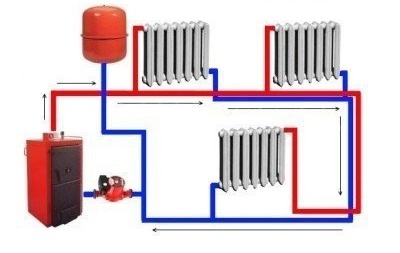
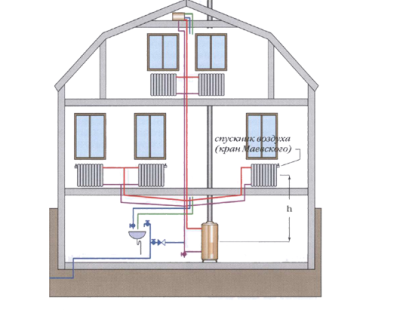
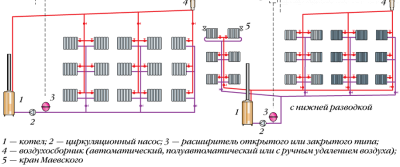


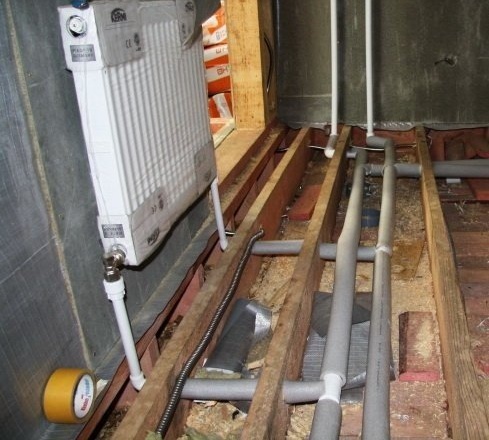
5 comments